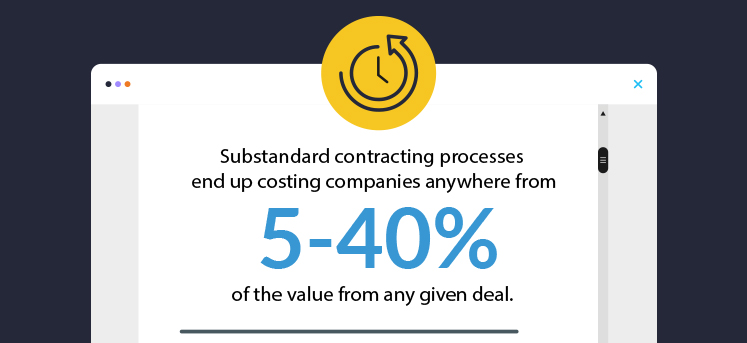Manual legal review hinders progress, eats into margins, and kills deals. It’s time for lawyers to adopt a smarter approach to contracting.
Contract negotiation has long been a core part of in-house lawyers’ responsibilities. It’s crucial that lawyers use their expertise to identify key issues that need to be negotiated and ensure that nothing slips through the net. Nobody ever thanks the lawyer for reviewing a contract thoroughly, but there is usually a lot of noise when they miss something.
But why do lawyers still rely on outdated and inefficient review processes when negotiating contracts?
This blog explores the ways in which purely manual legal review hinders effective contract negotiation, before introducing contract acceleration. This is a new approach that cuts complexity and increases speed, while reducing risk at the same time.

Why is manual legal review so slow?
Manual legal review has existed for centuries—so what’s the issue? As it turns out, there are several reasons why lawyers should look to adopt a faster and less stressful process.
Let’s examine a few of these in more detail.
Manual review is risky, creating time-consuming revision cycles
Manual contract review is a risky process. Miss something, and you might end up unwittingly signing your company up to a contract that created obligations to incur unwanted costs, or give away key data, for example. Therefore, lawyers painstakingly pore over the minutiae, redlining the clauses that they believe represent risk to the business, and to them professionally. The risk could be because they don’t like the language, or it could be because the language is unusual, and therefore risky because it’s not well understood.
For experienced professionals, this is a fairly straightforward—albeit time-consuming—process. Junior lawyers, however, may lack the experience or contract negotiation skills to discern what constitutes a threat to their organisation and what is just common parlance in their industry/in the legal profession.
Consequently, they can end up redlining or flagging common clauses that represent nothing out of the ordinary. This in turn means that the counterparty will need to review, understand, and agree those redlines. It’s a vicious circle of work.
The burden of risk leads to crippling perfectionism and endless review cycles. According to the International Association for Contract and Commercial Management (IACCM), significant revision or renegotiation of contracts has increased by 40% in recent years. Worse still, much of this process is spent picking apart unclear (and often unimportant) legalese, rather than on getting to the core of the contract.
It’s common knowledge that time kills deals. The longer a contract is ‘stuck in legal’, the greater the chance that the deal will fall through. But that doesn’t mean that inside counsel should instead hurry over contract review, missing key issues in the hope of rushing the deal over the line. If they do, they run the risk of subjecting their company to unwanted (and unforeseen) issues and jeopardising their own careers in the process.
Manual review hinders effective issue management
The crucial core of the contracting process is identifying key issues that need to be negotiated. In-house lawyers need to ensure that their company is not going to be adversely affected by the contract, that no hidden clauses bind their company to unfavourable practices.
As such, it is considered best practice to create a comprehensive issues list, but this process is painful and time-consuming. It requires ongoing management of the list and collaboration with multiple parties (often via email), to keep things on track and steer the deal towards a conclusion.
Creating, managing, and monitoring a contract negotiation issues list is a cumbersome process, therefore it is usually reserved for only the biggest, most important contracts. But this best practice approach could be applied to all deals, if lawyers had a simple method to create and manage a contract issues list every time.
Why speed is of the essence
Momentum is crucial to getting deals over the line. The longer it takes to review, negotiate, and agree a contract, the greater the likelihood that circumstances, priorities, or personnel might change, blowing the deal off course, or sinking it completely.
Manual legal review slows deals down to a crawl. What’s more, any financial benefit negotiated can be effectively reduced by the endless review cycles—adversely impacting the bottom line. In fact, some estimates suggest that substandard contracting processes end up costing companies anywhere from 5-40% of the value from any given deal.

What lawyers should really focus on
Lawyers should be empowered to make the most of their valuable expertise by providing strategic guidance on the advanced legal aspects of contract negotiation. But manual contract review has even the most skilful and experienced lawyers trapped poring over the minute details of contract wording.
Unpacking legalese is certainly tricky, and a valuable skill, but it’s not how experienced lawyers should be spending their days. For legal departments to unlock their team’s potential, they need to arm them with tools that help focus their time and energy on big-picture, value-added activities.
Embrace contract acceleration
It’s time to do away with purely manual legal review and embrace contract acceleration via a technology-assisted review. For lawyers, this will greatly reduce the risk burden and enable easier issue management. The business benefits are clear, as faster contract negotiation means more deals signed.
Contract acceleration allows lawyers to harness AI-based technology to scour documents quickly, flagging the key issues. ThoughtRiver’s platform facilitates the creation and ongoing management of a detailed issues list, providing an all-in-one hub where lawyers and their business colleagues can review, collaborate on, and finalise contracts with greater ease and effectiveness.
Key takeaways
- Manual legal review is too slow, requires endless revisions, and hinders effective issue management—which unintentionally jeopardises deals and eats into margins.
- In-house lawyers’ expertise is much better focussed on key strategic activities like devising contract negotiation strategies.
- ThoughtRiver’s contract acceleration platform makes it easy for inside counsel to review contracts and pinpoint key issues, track the contract negotiation progress, and steer the deal towards a swifter conclusion.




